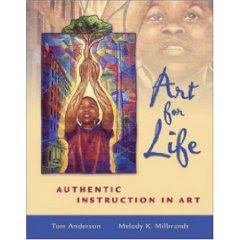“An arts classroom gives children the time and place to confront images of war and violence and decode the multiple levels of meaning (Arnold, 1997) found within them.”
“The third, fourth, and fifth-grade students in my university preservice "after-school-art" class looked at several narrative works by Francisco Goya, Kathe Kollwitz, Frank Gaylord, II, and Pablo Picasso, and discussed the stories and imagery in each.”
“Each student interpreted the many themes found in the artworks within the context of their personal lives.”
“The experience was a time of discovery and a time to confront the multiple realities of their lives.”
“A desire to protect children from the harsh realities of life may cause teachers to avoid showing children art that has difficult imagery. Yet, a strong and powerful understanding of the human condition can be gleaned from the presentation of the array of subjects found in artworks-with an array of emotional expression (Broudy, 1972).”
Exploring Questions-Without-Answers through the Arts
“The teacher and students raised critical questions (Giroux, 1988) in rapid-fire succession. Every voice was heard, yet no set answers were given, only speculation and debate. The students gave one solution and then another as they became involved with the deeper meanings of each work.”
“The students’ discussion and explanations became a way for them to make sense of these large and complex paintings. Careful analysis of the detail and complexity in the paintings provoked ideas and many questions (Broudy, 1987).”
“This collaborative viewing process, where each answer was respected and considered, gave the children time to peel away the multiple themes related to war and reveal greater realities about war: the tragedy, sorrow, loss, and despair. For example, the students' collages revealed that a personal awareness of the aftermath of war was a reality for each child.”
Multimodal Arts Explorations
“After viewing and discussing reproductions of the works, the children experimented with heavy collage materials…”
“Each student moved back and forth between the expressive modalities of speech, drawing and pasting, gesture and movement, and writing with great fluency (Pahi, 2003).”
Re-creating the Guernica Theme with Personal Stories
“The children's art and writing shows a great degree of personal identification with the chaotic aftermath of war.”
Aesthetic Confrontations
“The children seemed to pull inspiration from many realms of their world-from the artwork as well as from their "everyday aesthetic" (Duncum, 1999).”
“There was a level of authenticity in the images that revealed that most of the young artists had placed themselves at the center of the blast, just as Picasso had in Guernica.”
“The art room can be a place of differences and debate as well as shared hopes for the future.”
“Discussing feelings about art can be both instructive and cathartic.”
Examining Beliefs
“Children are continually exposed to traumatic events through the media.”
“Images are too often presented in rapid-fire succession with very little time for processing or reflection. Children can become bewildered and depressed when asked to understand events that are developmentally beyond their years (Elkind, 2001).”
“In the art classroom on the other hand, children have time to confront important themes. The process of viewing, listening, discussing, and then creating, allows the child to place information in a context that makes it more understandable (Bruner, 1977).”
“The artistic process can create a safe place for children to address long-held beliefs and prejudices.”
“Discussion of art with serious themes can encourage a new analysis and understanding and move the theme to a more abstract and universal level.”
“The Prisoners, The Shootings of May Third 1808, the Korean War Memorial, and Guernica are quite different from each other and run through a range of expression, from betrayal and desolation to terror. These images…call for an examination of the essential nature of war: power, aggression, chaos, and loss. They call for a discussion of beliefs about the culturally popular myths that glorify war and create the dichotomies of good-guys/bad-guys, and hero/victim (Giroux, 2000).”
Multimodal Learning
“With time and practice, children become better at expressing themselves in myriad ways.”
“Those with fewer linguistic skills may prefer the medium of the dance, the play, the song, or the visual arts to give voice to their ideas (McGuire, 1984).”
“When several sensory and expressive modalities (visual, auditory, oral and kinesthetic) are combined in a lesson, the potential for perceptual understanding and expression is enhanced (Arnold, 1997).”
“Ideas become more specific and powerful when artmaking and writing are coupled.”
Conclusion
“Children need the opportunity to give expression to life events that are tragic or senseless to them. They need time and permission to reflect in meaningful ways on events over which they have no control. The artistic process can provide such an avenue.”
Subscribe to:
Post Comments (Atom)






During reading of the post, it has been observed that you have lot of knowledge regarding subject matter. I must say it a wonderful effort, please keep your chin up.
ReplyDeletecustom writing help
An art in education gives students hobbies and the skills needed to make better choices. It shows them alternate ways to entertain themselves and gives them goals. When students are provided with other ways to entertain themselves then they will diverge from the path of criminal acts.
ReplyDeleteArts and Education